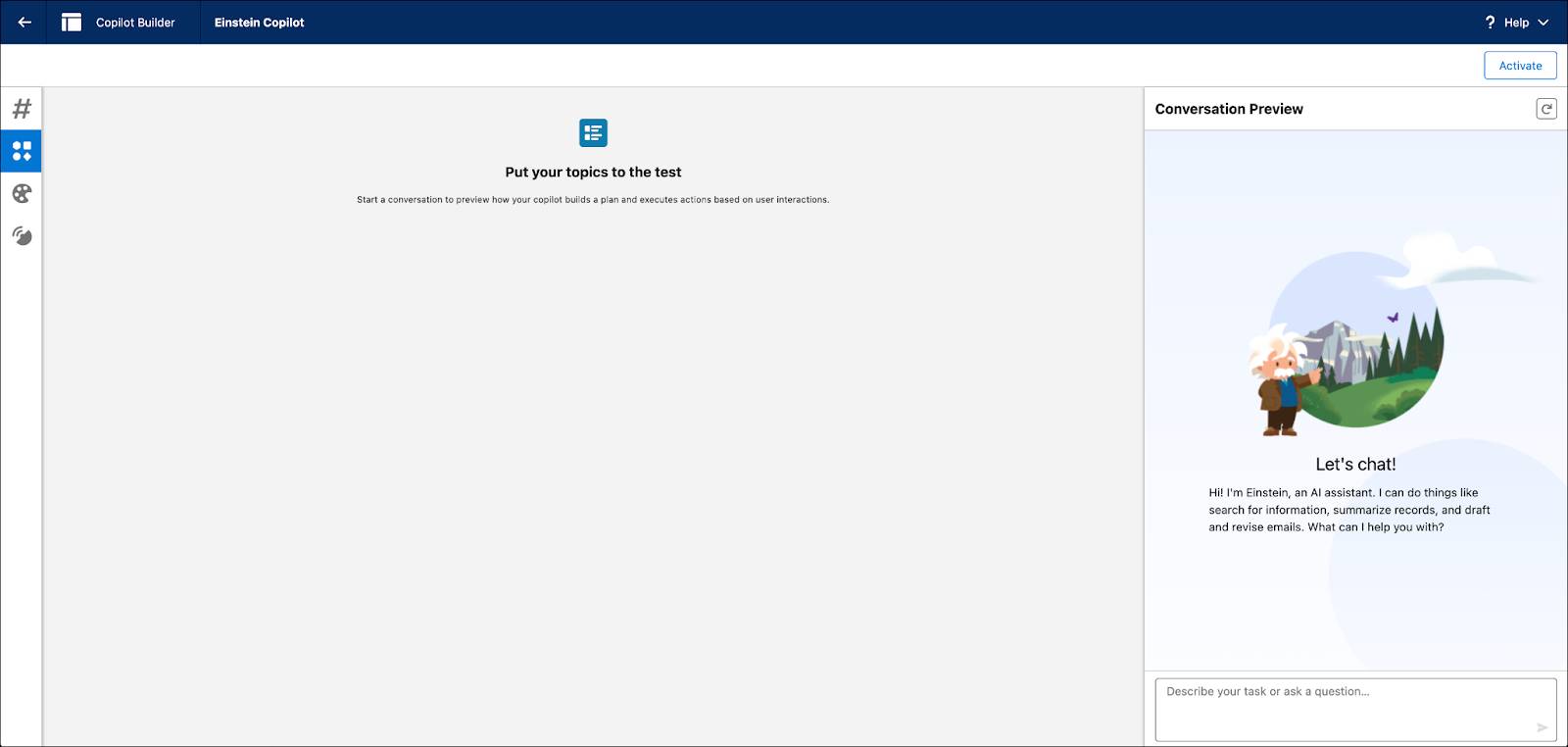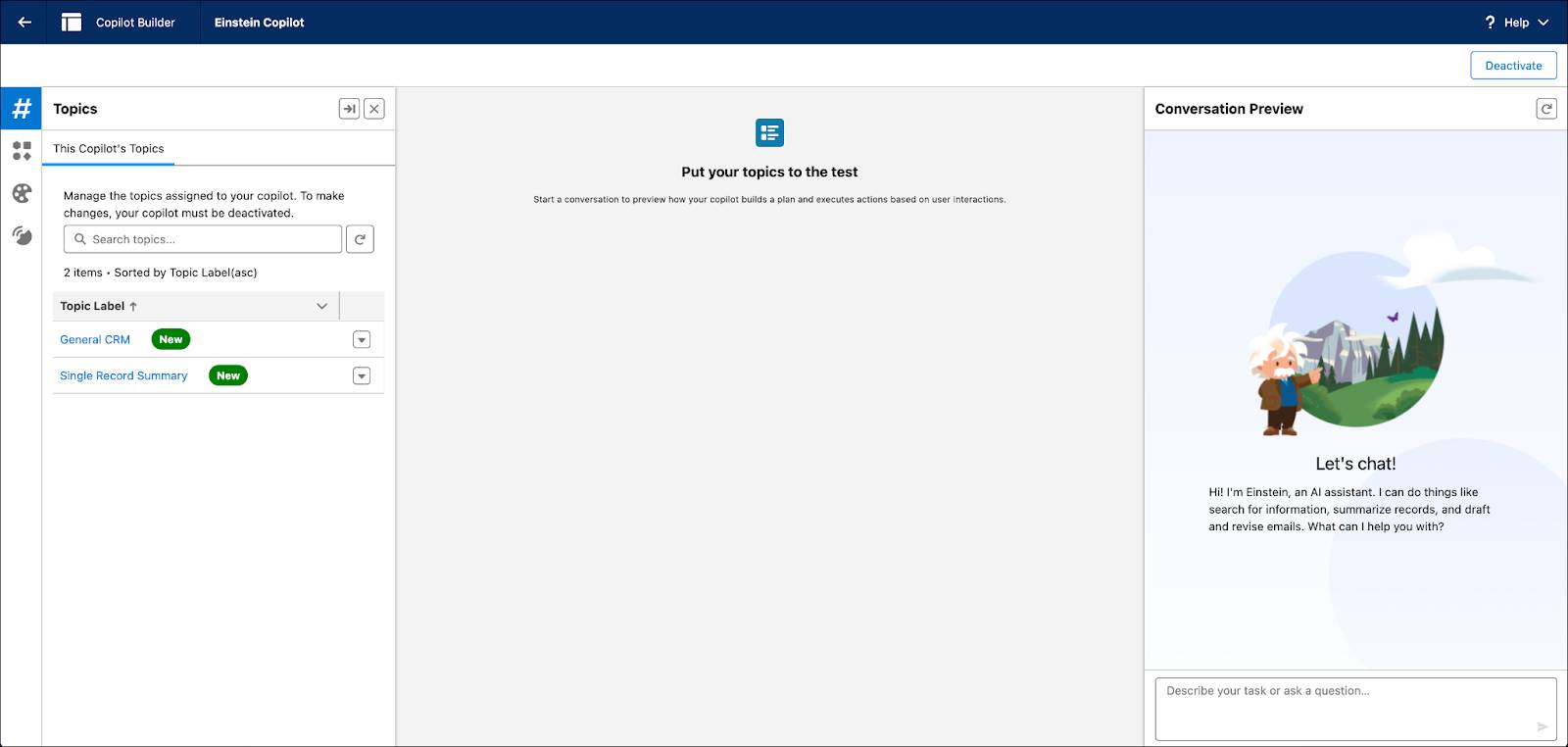Test and Activate an AI Agent
Learning Objectives
After completing this unit, you’ll be able to:
- List the best practices for testing an assistant.
- Test an assistant to see how it performs.
- Grant users permission to access Agentforce.
- Activate an assistant.
- Explain how to monitor an assistant and evaluate the performance.
The Final Stretch
Believe it or not, by the end of this unit Linda will have successfully launched an AI agent in Cloud Kicks’s Salesforce org, achieving the first of many AI-driven productivity boosts for her users. But how does she do it?
This final stretch of Linda’s journey begins with a test drive of Cloud Kick’s assistant, and it ends with happier, more efficient users. So let’s hit the road!
The Importance of Testing
If you’re a Salesforce admin or developer, you understand how important it is to test new technology and software before releasing it to users.
Don’t launch your new assistant without testing it first to ensure good performance. Does the assistant accurately interpret a user’s request or instruction? Does it launch the right actions? Does it provide helpful, accurate responses?
Of course, all the tools you need for testing your assistant are baked right into the Agent Builder. Here are a couple of tips to get you started with the testing process.
-
Think like a user: Test the assistant with requests your users might make. What types of users will have access to the assistant? What questions are they likely to ask during an assistant conversation? What terminology and wording would they use? Consider creating a spreadsheet to track sample user inputs to make sure you’re covering a wide variety of test cases and scenarios. We recommend testing with at least 30 user inputs to ensure good performance.
-
Use dummy data: You don’t want to accidentally update real customer data during the testing process. Make sure you have a set of dummy records in your org that you can use when you’re testing an assistant.
-
Test on Salesforce Mobile: Think of how your users might interact with Agentforce on Salesforce Mobile, and test out some scenarios after activating your assistant. Try out voice input and be wowed by its magic.
Simulate a Conversation with Agentforce
Linda’s ready to roll up her sleeves and get ready to test! As you learned during the tour of the Agent Builder UI, Linda will use the Conversation Preview panel to simulate how a user might interact with the assistant.

Linda comes up with a request that one of her sales reps might make during an assistant conversation. She types, “Summarize the Acme deal” in the chat window and presses Enter.
As Linda interacts with the assistant in the chat window, the Plan Canvas dynamically updates, and Linda watches as the reasoning engine builds a plan and launches actions to carry out the request.
After the assistant is done working on her request, it provides the exact response Linda was looking for: a summary of the Acme opportunity. Linda reviews the list of actions the reasoning engine triggered to get that response. Everything looks good, so her first test was a success! She continues this process until she’s covered all the necessary test cases to ensure a good experience for her assistant users.
Monitor and Troubleshoot User Interactions
As you can imagine, Linda is thrilled about the positive outcome of her first test conversation with Cloud Kicks’s assistant. But what if her test had failed? Maybe the assistant triggered the wrong action, returned an error, or generated an inaccurate response. How would Linda troubleshoot those issues?
One tool Linda can use is the event logs. We introduced event logs in the previous unit. Let’s take a closer look now.
To view the event logs:
- Make sure the assistant is open in the builder.
- Select the Event Logs tab.
Linda can see all the interactions that have happened so far with the assistant. She can go to a particular session to debug the assistant’s performance and get to the bottom of any issues, such as errors, incorrectly triggered actions, or incomplete plans.
The event logs are an invaluable troubleshooting tool during the testing phase and beyond. After the launch, Linda can use the logs to monitor and troubleshoot the assistant’s interactions with her Salesforce users.
Enable User Permissions
Let’s fast forward to the point where Linda has successfully completed all her testing, and she’s ready to launch the assistant in her Salesforce org. To make the assistant available to users, Linda has to grant users permission to access the feature and activate the assistant. Let’s enable the permission set first.
Remember, Linda and the Cloud Kicks leadership team decided to start small and roll out Agentforce to a limited number of users to get feedback before making the assistant widely available. She thinks Cloud Kicks’s sales reps will get a huge productivity boost by using an AI agent in Salesforce, so she enables the feature for key members of the sales team first.
To assign user permissions:
- From Setup, enter
Usersin the Quick Find box, then select Users.
- In the list view, click the user’s name to view the user details page.
- Scroll down to the Permission Set Assignments section, then click Edit Assignment.
- Select the Access Agentforce Default Agent permission set, then click Add.
- Click Save.
- Repeat the process for other users who need access to Agentforce.
Get Ready for Launch
Linda is getting close to launching Agentforce in her org! Before she flips the switch and activates her assistant, she makes sure her users are prepared to use an AI agent in Salesforce.
Thankfully, Linda has been following the company’s standard change management process to ensure a successful rollout of Agentforce, which includes things like creating a communication plan and training end users so they get the most out of the feature. We recommend you do the same.
To learn more, check out the Change Management for AI Implementation module.
Activate Agentforce
Linda’s big moment has finally arrived! With the necessary user permissions in place, the only remaining step is activating the assistant. Activating the assistant makes it immediately available to users and allows them to interact with it. Here’s what she does.
- From Setup, enter
Agentsin the Quick Find box, and then select Agents.
- Click the name of your assistant.
- Click Open in Builder.
- Click Activate.

Cue the fanfare and the confetti! The new AI agent is now available to Cloud Kicks’s sales reps to help them with common business tasks in Salesforce, both on desktop and mobile devices. Cloud Kicks’s AI transformation is well underway.
Happy Users, Happy Admin
A couple weeks after the launch, Linda gathers feedback from the sales reps using Agentforce. Linda sends out a quick survey to get more details about the benefits of having an AI agent in Salesforce.
On average, the sales reps estimate that they’re saving about 1 hour a week by using Agentforce, which means Cloud Kicks’s new AI agent is making users more productive. The sales reps are thrilled because time is money. And that means Linda is thrilled, too. Happy users make a happy admin!
Best of all, Linda knows her users’ productivity gains will only increase as Cloud Kicks rolls out the assistant to more users and starts to implement use cases for custom topics and actions. And it goes without saying that Agentforce will only get more powerful in later Salesforce releases. The future looks bright!
Resources
- Salesforce Help: Troubleshooting Agents and Assistants